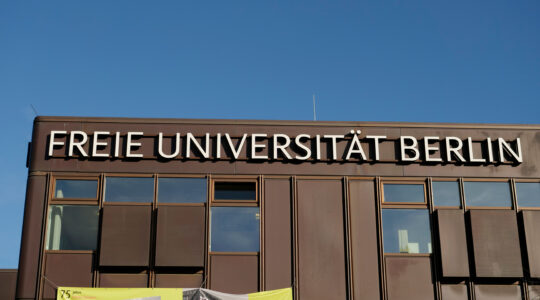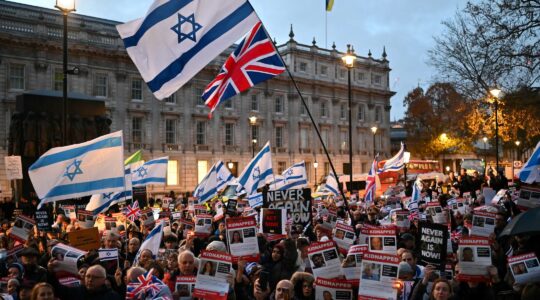VILNIUS, Lithuania (JTA) — Inside the Vilnius Zveryno High School, the Lithuanian teens greet a guest to their Tolerance Center as they would a teacher — standing at attention. Striking Holocaust images painted by the teens cover the blackboard: mostly watercolors of Jews deported, torn from loved ones, trapped behind barbed wire. In the back of the classroom, a cabinet has become a permanent exhibit, its doors opened to reveal a miniature concentration camp built of wood, clay and paper. “We need to learn our country’s history and what our ancestors did — it was very cruel,” says Ruta Vastakaite, speaking, like her classmates, in near-flawless English. “Some thought they were better than the Jews,” Linas Budrys adds, “and that Jews should have no rights.” “Only when we know our own history can we prevent it from happening again,” Ieva Kerzaite concludes. The words are an encouraging sign considering that not a single student in the class is Jewish. That’s not surprising in a country that before World War II was a center of Jewish life but which today has no more than 5,000 Jews. As in the neighboring Baltic states of Latvia and Estonia, Holocaust education in Lithuania is a tricky business. Not only were the Jewish populations in the Baltic countries decimated by the Nazis, many of their own countrymen took part in the killings.Approximately 220,000 of the 250,000 Jews in Lithuania were killed, and 90,000 of 100,000 in Latvia. Only seven of the estimated 1,000 Jews survived the onslaught in Estonia. Teaching children about those atrocities may mean implicating their own grandparents and denting national pride that was allowed to grow only with independence 16 years ago. Critics charge that some in these small ex-Soviet republics tend to deal with this complexity with a form of Holocaust denial: not denying the Holocaust per se, but rejecting local culpability and pinning blame entirely on the Germans. Indeed, in contrast to other European countries, no Baltic nation has ever imprisoned a local Nazi war criminal. “You have to be very savvy about the Holocaust education being taught,” says Efraim Zuroff, director of the Simon Wiesenthal Center’s Nazi-hunting office in Israel.Five years ago the office launched “Operation Last Chance,” which offers cash rewards for information leading to prosecutions of war criminals from the Baltics and other countries. “Is local complicity an important component?” Zuroff asked. “Or are they engaging in Holocaust deflection, dealing only with the easier part — what Germany and the Nazis did?” One more question can be added: Are the Vilnius Zveryno students the rule or the exception? In Latvia, which has about 200 sites where Jews were killed, some youth are in the dark about what happened or feel disconnected from it, says Gita Umanovska, executive director of the Riga Jewish community. “Maybe in their town of 3,000, 1,000 Jews were killed in the woods,” Umanovska says. “Maybe they don’t know, or don’t want to know. They may feel it happened over there, but we’re over here; it’s not a part of my history, my town, my family.” In some cases, the government isn’t helping. President Vaira Vike-Freiberga has apologized for Latvian participation in the Nazi slaughter, but an official Latvian history book — produced in 2005 — described Salaspils, the country’s main concentration camp, as a “corrective working camp.” In reality, some 50,000 people were killed there. Complicating the picture is that while Lithuania, for example, had one of Europe’s highest rates of collaboration with the Nazis, Yad Vashem has honored 693 Lithuanians as “Righteous Gentiles” among the more than 21,700 so recognized. From Latvia, 103 righteous have been identified; from Estonia, three. A memoir of more than 100 Lithuanian ghetto and camp survivors, “With a Needle in the Heart,” cites countless instances of ordinary folks helping Jews. In addition, the Baltic states endured their own wartime trauma: The Soviet “liberators” deported hundreds of thousands of people to Siberia, and executed or imprisoned many others. More attention to crimes against Jews might not resonate here, nor would puncturing these nations’ own sense of victimization. The Holocaust itself was a taboo topic for a half-century. Soviet propaganda would refer generically to the “Soviet victims of fascism,” never the “Jewish victims.” Compared with Western countries like France and Austria, which took four decades to confront their past, “I’d say Holocaust education in the Baltics is moving in a positive direction, but the question is the speed and intensity,” says Rabbi Andrew Baker, director of international Jewish affairs for the American Jewish Committee. “One can understand, if you’re talking about the Holocaust in general, there’s little opposition — the United Nations itself has recognized it. But when it comes closer to home, it increases sensitivity. “Here we are trying to peel back decades of history to address a problem never critically reviewed,” he says. “It’s difficult for people who see themselves as victims to imagine their grandparents may also have been perpetrators or bystanders.” Nevertheless, once the Soviet regime crumbled, the Baltics joined fellow Eastern European countries in saying the right things: apologizing for the Holocaust and vowing to commemorate it, resolve issues like restitution and prosecute war criminals. Holocaust education essentially was a precondition for any country presenting itself as a decent, modern society with hopes of joining exclusive Western clubs like the European Union or NATO. The Baltic countries joined both organizations in 2004. But backing up words with action has lagged, leading some to question the sincerity of the mea culpas. When Council of Europe member nations declared their intention in 2000 to commemorate the Holocaust, Estonia, facing domestic resistance, designated Holocaust Day on Jan. 27, 2003 — not pegged to any date symbolizing local participation but to the liberation of Auschwitz.Lithuanian officials, though, note that their Holocaust Day was created a decade earlier, before they learned they would join either institution. “We were doing this for ourselves because everybody knows what happened to the Jews here,” says Rimantas Jokimaitis, a historian who is responsible for history textbooks in Lithuania’s Education and Science Ministry. “I think we do a lot because it’s impossible to discuss Lithuanian history without the Holocaust. It’s a part of our history.” The ministry also sponsors an annual writing competition for teens entitled “My Grandparents’ Neighbor Was Jewish,” and has compiled the best essays into books. It also provides some funding for the 46 Tolerance Centers like the one at Vilnius Zveryno High School. But these centers aren’t located in every Lithuanian high school, and their activities are voluntary, held after school. Lithuania also has no specifically designed Holocaust-studies course. Instead, lessons are folded into the broader history curriculum for students in the fifth, 10th and 12th grades. Jokimaitis shows a visitor a history book for 16- and 17-year-olds. The Holocaust chapter starts with “Destruction of the Lithuanian Jewish Community.” Subsections highlight telling anecdotes from the era: a Lithuanian police officer’s letter to superiors explaining how they killed Jews; a police report questioning what to do about a priest who wouldn’t let killers of Jews into his church; a newspaper advertisement proclaiming that Lithuanians who help Jews would share their fate. Yet the chapter runs just six pages. “It wasn’t treated as something separate, just a part of history,” Benjaminas Krumas, 23, recalls of his high school lessons in Kaunas, known to Jews as historic Kovno and home to a ghetto liquidated by the Nazis in 1944. “Perhaps the teacher had her own point of view on it or was afraid to discuss it more. But we learned more about it from our grandparents.” Indeed, history teachers like Arija Melaikiene play a pivotal role. Both the Ministry of Education and the Lithuanian Jewish community recommended the Tolerance Center that Melaikiene founded at Vilnius Zverynas. It was seven years ago that Melaikiene had an epiphany. She had assigned her students to draw up family trees as a springboard to discussion of Lithuania’s various regions and names, as well as other topics. One girl, by the name of Finkelsteinaite, turned in her assignment with half the tree lopped off. “Everyone had died in 1942 or ’43,” Melaikiene recalls. “At first I thought she was too lazy to draw a real family tree. Then I realized what had happened.” It was cathartic, Melaikiene says. “I decided that I hadn’t been a very good teacher because I hadn’t been paying attention to the most important facts,” she says. That led to an immersion in Jewish history, Jewish contributions to Lithuanian culture, visits to Auschwitz and Yad Vashem — and a commitment to preach tolerance. Melaikiene speaks of three categories of Lithuanians during the Holocaust — those who killed, those who turned a blind eye and those who helped Jews in some way — but admits to treading carefully when broaching the first two categories with students. “I have to find a middle ground, talking about both good guys and bad guys,” she says. “If there are some students who don’t believe it, I don’t want the other students to think badly of them because they’re rejecting what I’m saying.”I don’t know whose grandfather did what, but I can guess: If there’s a usually very active student, then we talk about the Holocaust and his activity disappears, I tell them, ‘Don’t hate your grandfather if he killed somebody because he’s still your grandfather and you love him.’ But if he killed someone, then it’s a fact and we have to say this. It’s a tragedy for that family.” Others trying to connect with students are the Holocaust survivors themselves — like Kaunas-born Fania Brancovskaja-Jocheles, 84, who escaped the Vilnius ghetto alone. Her mother, father and sister were among 50 relatives killed. In recent years, Brancovskaja-Jocheles has shared her story with classes in Lithuania. She also has traveled to Germany and Austria to recount her experiences. “I tell them not only who was killing us but who was saving us, which is why I also tell them to talk to their grandmother and grandfather,” Brancovskaja-Jocheles says, pulling mementos from her shelves to show a visitor. “I don’t want to threaten people, only for them to know the truth,” she says. “Those who were killed cannot speak, so I must. And if you tell them from your heart, even in a little way it may go to their brain and help them prevent bad things from happening in the future.” Despite such campaigns, observers say the Baltic countries remain prone to anti-Jewish eruptions, especially in the media or on the Internet. That’s most evident in the torrent of vitriol unleashed amid stalled negotiations to return Jewish property or bring accused Nazi-era war criminals to justice. “Excluding the good efforts of hundreds of teachers and historians devoting their time to the memory of the Holocaust, the level of reaction and distrust is so great, I’m shocked by the reality 16 years after Lithuanian independence,” says Emanuelis Zingeris, the lone Lithuanian Jewish parliamentarian, who is among the lobbyists for restitution. With the carrot of Western integration digested, the stick has vanished as well. Lacking that leverage, Jewish activists like Baker say they now rely on a network of Baltic politicians, historians and teachers like Melaikiene. Ultimately, though, there is no way to gauge if any of this Holocaust education “works.” As Latvia’s Umanovska says, “We have no special system to check it.”
JTA has documented Jewish history in real-time for over a century. Keep our journalism strong by joining us in supporting independent, award-winning reporting.





